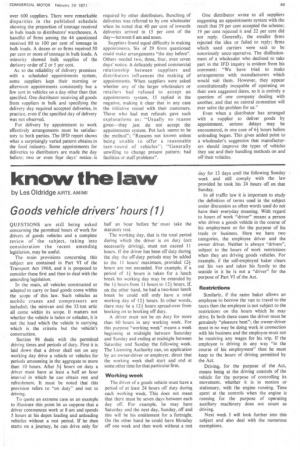know the law
Page 51

If you've noticed an error in this article please click here to report it so we can fix it.
by Les Oldridge AIRTE,ArvlIMI
Goods vehicle drivers' hours (1 )
QUESTIONS are still being asked concerning the permitted hours of work for drivers of goods vehicles and a complete review of the subject, taking into consideration the recent amending legislation, may be useful.
The main provisions concerning this subject are contained in Part VI of the Transport Act 1968, and it is proposed to consider these first and then to deal with the amending legislation.
In the main, all vehicles constructed or adapted to carry or haul goods come within the scope of this law. Such vehicles as mobile cranes and compressors are included; the minivan and the 32-ton artic all come within its scope. It matters not whether the vehicle is laden or unladen, it is not the load which the vehicle is carrying which is the criteria but the vehicle's construction.
Section 96 deals with the permitted driving times and periods of duty. First it is laid down that a driver shall not on any working day drive a vehicle or vehicles for periods amounting in the aggregate to more than 10 hours. After 51 hours on duty a driver must have at least a half an hour interval in which he can obtain rest and refreshment. It must be noted that this provision refers to "on duty" and not to driving.
To quote an extreme case as an example to illustrate this point let us suppose that a driver commences work at 8 am and spends 5 hours at his depot loading and unloading vehicles without a rest period. If he then starts on a journey, he can drive only for half an hour before he must take the statutory rest.
The working day, that is the total period during which the driver is on duty (not necessarily driving), must not exceed 11 hours. lithe driver has been off duty during the day the off-duty periods may be added to the 11 hours' maximum, provided 12+ hours are not exceeded. For example, if a period of 1+ hours is taken for a lunch break his working day may be extended by the 1; hours from 11 hours to 12+ hours. If, on the other hand, he had a two-hour lunch break he could still only have a total working day of 12; hours. In other words, there may be a 12+ hours spread-over from booking on to booking off duty.
A driver must not be on duty for more than 60 hours in any working week. For this purpose "working week" means a week beginning at midnight between Saturday and Sunday and ending at midnight between Saturday and Sunday the following week. The Licensing Authority can, on application by an owner-driver or employer, direct that the working week shall start and end at some other time for that particular firm.
Working week
The driver of a goods vehicle must have a period of at least 24 hours off duty during each working week. This does not mean that there must be seven days between each day off. For example, he may have Saturday and the next day, Sunday, off and this will be his entitlement for a fortnight. On the other hand he could have Monday off one week and then work without a rest day for 13 days until the following Sunday week and still comply with the law provided he took his 24 hours off on that Sunday.
In all traffic law it is important to study the definition of terms used in the subject under discussion as often words used do not have their everyday meaning. With regard to hours of work "driver" means a person who drives a goods vehicle in the course of his employment or for the purpose of his trade or business. Here we have two categories, the employee driver and the owner driver. Neither is always "drivers", subject to the hours of work restrictions when they are driving goods vehicles. For example, if the self-employed baker clears Out his van and takes his family to the seaside in it he is not a "driver" for the purpose of Part VI of the Act.
Restrictions
Similarly, if the same baker allows an employee to borrow the van to travel to the races then the employee is not subject to the restrictions on the hours which he may drive. In both these cases the driver must be genuinely "pleasure bent"; the owner-driver must in no way be doing work in connection with his business and the employee must not be receiving any wages for his trip. If the employee is driving in any way "in the course of his employment" then he must keep to the hours of driving permitted by the Act.
Driving, for the purpose of the Act, means being at the driving controls of the vehicle for the purpose of controlling its movement, whether it is in motion or stationary, with the engine running. Time spent at the controls when the engine is running for the purpose of operating auxiliary machinery does not count as driving.
Next week I will look further into this subject and also deal with the numerous exemptions.




























































































